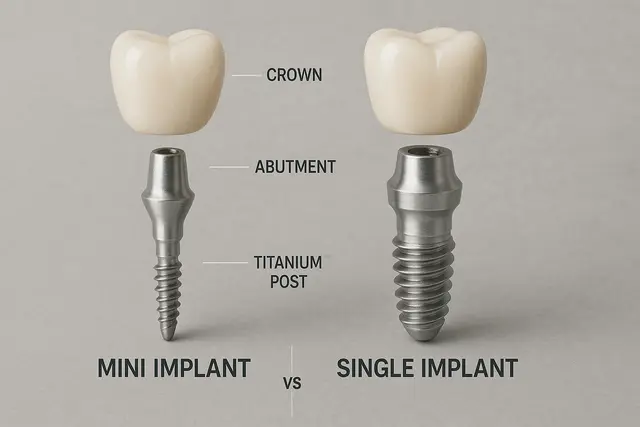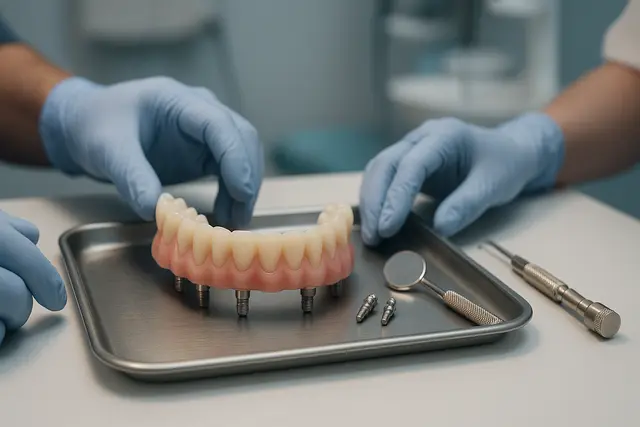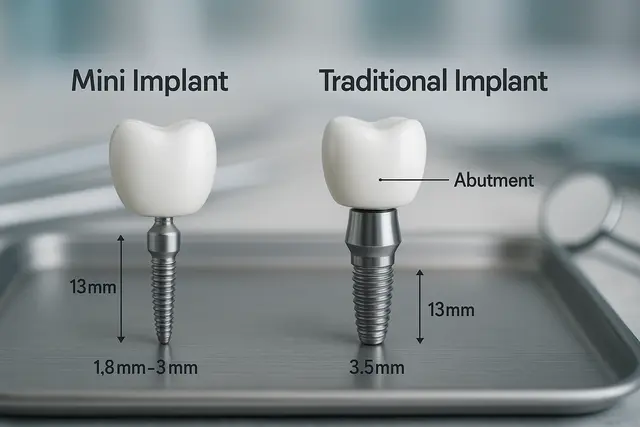Prosthodontics
6 min read
Oct 15, 2025
Immediate Load Implants Overview: Faster Smiles With Same-Day Solutions
Dental implants have come a long way, and immediate load implants are leading the charge in modern tooth replacement. Offering same-day results with minimal downtime, this innovative solution is transforming smiles and redefining convenience in restorative dentistry.

Picture this: you walk into a dental office in the morning with a gap in your smile, and by afternoon, you’re flashing a confident grin on your way out. No drawn-out months of healing. No waiting in toothless limbo. That’s the promise of immediate load dental implants, the superhero of implant dentistry that’s rewriting what it means to “wait” for your smile.
Before you cancel your weekend plans for a brand-new set of pearly whites, let’s break down what immediate load really means, why it’s so talked about, and whether it’s the real deal or just dental hype.
Immediate Load Is Changing the Game
Immediate load means exactly what it sounds like: the implant and the replacement tooth (aka the crown) are placed on the same day. Unlike traditional dental implants that require months of waiting between implant placement and final restoration, immediate load implants let you walk out with a tooth that’s already doing its job, smiling, chewing, and showing off.
Here’s the wild part: the idea isn’t brand new. Immediate implant loading has been studied and practiced for years, with journals like Int J Oral Maxillofac Implants and Clin Oral Implants Res showing solid success rates. But thanks to advances in implant systems, digital scans, and 3D planning, the process is more predictable and accessible than ever.
Dental Implant Basics: What You’re Really Getting
Let’s back up for a second. A dental implant is a small titanium post (though other materials exist) surgically placed into your jawbone. It acts like an artificial tooth root, holding up a crown or bridge.
The whole idea is to mimic the function and feel of a natural tooth. The implant body fuses with your bone through a process called osseointegration, basically, your body accepting this foreign object as its own. That bond is key. If it doesn’t happen right, that’s when things go sideways with implant failure.
Traditional dental implants usually involve a healing period of 3 to 6 months before the crown is attached to the implant. Immediate load dental implants? They fast-track that process.
Implant Placement That Works on Your Schedule
The timing of implant placement matters a lot. Here’s a quick rundown of the options:
Immediate placement: The implant is placed right after tooth extraction.
Early loading: The implant is placed, then loaded with a crown a few weeks later.
Delayed implant: Healing time comes first, usually a few months, before the implant is placed.
With immediate implant placement, the bone is still fresh and ready to hug that implant tight. Add in a stable implant system and good bone density, and you’ve got the perfect storm for immediate function.
Now, not everyone is a suitable candidate for immediate load. But if the conditions are right? It can be a game-changer.
Immediate Load Implants Feel Like Instant Gratification Without the Risk
So, what’s the big draw?
Immediate load implants are loved for the convenience of immediate results. You skip the awkward flipper denture phase and head straight to having teeth again. Multiple implants placed in one visit can restore entire arches. For patients, that means fewer surgeries, fewer visits, and a lot less self-consciousness.
The implant loading protocols used today are tailored to reduce the risk of implant failure. The crown placed during the immediate loading procedure is usually temporary and non-load-bearing at first, meaning you’re not biting into an apple with it right away. It looks real but gives the implant time to solidify beneath the surface.
Eventually, that temporary crown gets swapped out for a permanent one, once your dentist confirms the implant has integrated well.
Loading Dental Implants the Smart Way
There are three main approaches to loading of dental implants:
Conventional loading: Wait 3–6 months after implant surgery before placing the crown.
Early loading implants: Crown goes on 1–2 months after implant placement.
Immediate loading procedure: Crown is attached right away, within 48 hours of surgery.
The differences between immediate and early loading are small on paper but can be big in real-life healing. What matters is the quality of the bone, the stability of the implant insertion, and whether the patient follows the post-op rules (yes, that means soft foods and no chewing on ice).
When loading of implants is rushed without proper planning, implant failure can happen. That’s why choosing a dental professional who understands clinical procedures regarding loading protocols is essential.
Implant Placement and Loading: A Delicate Balance
The best dental implant outcomes happen when there’s harmony between implant placement and loading. If the implant isn’t placed in the right spot with the right angle, or if it’s loaded too soon with too much pressure, it can all go wrong. Think of it like planting a tree, if you hang a swing from it on day one, it might topple.
Today’s implant dentistry uses tools like CBCT scans and guided surgery to ensure precise placement. A tapered implant body, for example, can offer better primary stability in soft bone. And the surface of the implant, yes, even that tiny detail, can influence how quickly your bone bonds with it.
Immediate Implant Placement Done Right
Immediate implant placement can only work when there’s enough bone to support it. That’s where experienced clinicians come in. They’ll assess the implant surface, density of the bone, and use implant loading protocols that match your situation.
It’s not a one-size-fits-all game. The decision between immediate and delayed implants involves your overall oral health, bone quality, bite force, and even your daily habits (smoking, we’re looking at you).
And let’s be honest: immediate doesn’t always mean better. Sometimes, delayed placement is the safer bet to ensure long-term success.
Immediate vs. Traditional Dental Implants: What’s the Difference?
If you’re still torn between immediate and traditional dental implants, here’s a simple comparison:
Feature | Immediate Load | Traditional Load |
Timing of crown placement | Same day or within 48 hrs | 3–6 months post-surgery |
Looks like a tooth right away? | Yes | No |
Healing time | Similar, but under load | Healing without load |
Risk of implant failure | Slightly higher if poorly planned | Lower in stable cases |
Ideal for | Good bone, high stability | Most standard cases |
Known as immediate function | Yes | No |
Still wondering if you’re a candidate for immediate load implants? A dental implant procedure consultation can help you decide.
Pros and Cons of Immediate Load Implants
Let’s cut to it, what’s great and not-so-great about this approach?
Pros
Teeth on the same day (yes, really)
Fewer appointments
Avoids using removable dentures during healing
Helps preserve gum and bone structure
High satisfaction when done right
Cons
Not for everyone (bone quality matters)
Slightly increased risk of implant failure if rushed
Requires experienced planning and surgical skill
Temporary crown can’t handle heavy chewing at first
Ultimately, the success of immediate load comes down to using the right implant system, matching it with the right patient, and sticking to the right loading protocol.
Candidates for Immediate Load Implants: How to Know
You might be a suitable candidate for immediate load if:
You have good oral health and hygiene habits.
Your jawbone is dense and healthy.
You don’t grind your teeth.
You’re getting a single implant placement in the front of the mouth (which sees less bite pressure).
You’re replacing teeth with implants in edentulous areas that are stable.
Your dentist will also consider whether multiple implants are being placed, how the implant body fits, and how the temporary crown will function.
Implant System Matters, So Does Your Dentist
Not all dental implant systems are created equal. Some are designed specifically for immediate implant loading, offering better primary stability and faster osseointegration.
Your provider’s skill is also key. Clinical journals like Clin Implant Dent Relat Res highlight that the recommended clinical procedures regarding loading are what separate a success story from a “we’ll try again in six months” story.
So, if you’re thinking about immediate load dental implants, pick a dentist who knows how to make this process work for you. Ask questions. See examples. Don’t settle for guesswork.
What Are Immediate Load Dental Implants?
Immediate load dental implants are a type of implant procedure where a crown is placed on the implant within 48 hours of surgery, sometimes the very same day. This fast-track method skips the traditional months-long healing period and gives patients a functional, natural-looking tooth right away. While the crown placed initially is usually temporary, it helps restore aesthetics and basic function while the implant heals underneath.
Who Is a Good Candidate for Immediate Load Implants?
Ideal candidates have strong, healthy jawbone density, good oral hygiene, and no habits like teeth grinding or smoking that could interfere with healing. It’s especially effective for patients needing implants in the front of the mouth or replacing multiple teeth in stable areas. Your dentist will evaluate bone quality, bite pressure, and overall oral health before recommending this approach.
What Are the Main Benefits and Risks of Immediate Load Implants?
The biggest benefit is speed, you get a functional tooth immediately without relying on removable dentures during healing. It also requires fewer visits and helps preserve gum and bone structure. However, it’s not for everyone. If not planned correctly, it carries a slightly higher risk of implant failure. That’s why expert evaluation and adherence to loading protocols are key to long-term success.
How Do Immediate Load Implants Differ from Traditional Implants?
Traditional implants involve a healing period of 3 to 6 months before attaching a crown, allowing the bone to fully fuse to the implant without pressure. Immediate load implants skip that wait by placing a temporary crown right away. Though faster, they rely heavily on bone quality, implant stability, and proper technique. The choice between the two depends on your specific clinical situation and your dentist’s recommendation.
Read Next
Related Posts

Prosthodontics
Single Implant vs. Mini Implant: Key Differences, What Sets Them Apart
Missing teeth can impact everything from your confidence to your ability to eat comfortably. Thankfully, dental implants offer effective solutions, but not all implants are the same. Understanding the difference between a single implant and a mini implant can help you make the right choice for your needs.
5 min read
Oct 22, 2025

Prosthodontics
Permanent Fixed Implant Dentures Overview: Best Solution for Full-Mouth Restoration
Gone are the days when dentures meant bulky, uncomfortable teeth soaking in a bedside glass. Modern dentistry has completely transformed the way we approach tooth replacement, offering solutions that are more natural-looking, stable, and long-lasting than ever before.
5 min read
Oct 22, 2025

Prosthodontics
Mini Implants vs. Traditional Implants: How They Work and When to Choose Each
Missing teeth can impact more than just your appearance, they can affect your confidence, oral health, and ability to enjoy everyday activities like eating and speaking. Fortunately, dental implants offer a reliable solution. But when it comes to choosing between mini implants and traditional implants, the differences can be surprisingly significant.
5 min read
Oct 21, 2025
Don’t have time to research every dentist around you?
See why 30k+ patients trusted us